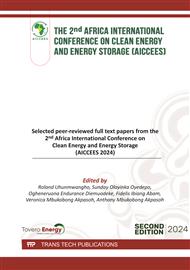[1]
State of Global Air Report, 'State of Global Air Report 2024', Boston, Mar. 2024. Accessed: Sep. 08, 2024. [Online]. Available: https://www.stateofglobalair.org/resources/report/state-global-air-report-(2024)
Google Scholar
[2]
N. Mopa Wambebe and X. Duan, 'Air quality levels and health risk assessment of particulate matters in abuja municipal area, Nigeria', Atmosphere (Basel), vol. 11, no. 8, 2020.
DOI: 10.3390/ATMOS11080817
Google Scholar
[3]
T. M. Chukwu, S. Morse, and R. Murphy, 'Assessment of Air Quality in Urban Settings in Nigeria: A Comparison of Perceptual Indicators, Causes and Management in Abuja and Enugu', 2023.
DOI: 10.3390/su14031438
Google Scholar
[4]
H. C. Ekoh, 'Spatial Variation of Air Quality in Mpape Area of Abuja, Nigeria', 2020, [Online]. Available: www.worldscientificnews.com
Google Scholar
[5]
P. N. Ndoke, U. George Akpan, and M. E. Kato, 'Leonardo Electronic Journal of Practices and Technologies Contributions of Vehicular Traffic to Carbon Dioxide Emissions in Kaduna and Abuja, Northern Nigeria', 2006, [Online]. Available: http://lejpt.academicdirect.org
Google Scholar
[6]
D. K. Lamichhane et al., 'Association between ambient air pollution and perceived stress in pregnant women', Sci Rep, vol. 11, no. 1, Dec. 2021.
DOI: 10.1038/s41598-021-02845-4
Google Scholar
[7]
M. R. Miller, 'Oxidative stress and the cardiovascular effects of air pollution', May 01, 2020, Elsevier Inc.
DOI: 10.1016/j.freeradbiomed.2020.01.004
Google Scholar
[8]
G. C. Gee and D. C. Payne-Sturges, 'Environmental health disparities: A framework integrating psychosocial and environmental concepts', Dec. 2004.
DOI: 10.1289/ehp.7074
Google Scholar
[9]
P. Hautekiet et al., 'Air pollution in association with mental and self-rated health and the mediating effect of physical activity', Environ Health, vol. 21, no. 1, Dec. 2022.
DOI: 10.1186/s12940-022-00839-x
Google Scholar
[10]
E. Lympson Okobia, E. Makwe, and L. L. O. Mgbanyi, 'Air Pollution and Human Health Implications in Urban Settlements of Abuja, Nigeria', 2021. [Online]. Available: https://www.researchgate.net/publication/354381904
Google Scholar
[11]
L. Bashiru and H. N. Ebede, 'Health Impact Assessment of Air Pollution in Some Selected States in Nigeria', 2017. [Online]. Available: www.ajouronline.com
Google Scholar
[12]
A. J. Ochala, A. Davies Obaromi, E. Innah, and P. E. Onoja, 'Monitoring Atmospheric Pollution Along Highways; A Case Study Abuja-Lokoja Highway, North-Central, Nigeria', 2021. [Online]. Available: https://lojas.org.ng
Google Scholar
[13]
S. Cohen, 'PERCEIVED STRESS SCALE', 1994. [Online]. Available: www.mindgarden.com
Google Scholar
[14]
MIT OpenCourseWare, 'Statistics for Applications', 2016.
Google Scholar
[15]
A. Vlachos, 'Notes on exponential family distributions and generalized linear models', 2010.
Google Scholar
[16]
WHO, 'WHO global air quality guidelines. Particulate matter (PM2.5 and PM10), Ozone, nitrogen, dioxide, sulfur dioxide and carbon monoxide. ', Geneva, Sep. 2021. Accessed: Sep. 22, 2021. [Online]. Available: https://www.who.int/publications/i/item/9789240034228
Google Scholar
[17]
M. S. Shehu, I. Umaru, and B. W. Tukura, 'Health Impact Analysis of Some Outdoor Atmospheric Aerosols (Pm 2.5 , SO 2 , CO & CH 4 ) in F.C.T Abuja and Environs', Am J Public Health Res, vol. 7, no. 1, p.1–8, 2019.
Google Scholar
[18]
I. D. Sulaymon et al., 'PM2.5 in Abuja, Nigeria: Chemical characterization, source apportionment, temporal variations, transport pathways and the health risks assessment', Atmos Res, vol. 237, Jun. 2020.
DOI: 10.1016/j.atmosres.2019.104833
Google Scholar
[19]
O. Calistus Chidebelu, N. Eno-obong S, and U. Pius O, 'Evaluation of the meteorological, air quality in the urban and rural areas of rivers state, South-South, Nigeria', MOJ Ecology & Environmental Sciences, vol. 9, no. 2, p.46–53, Mar. 2024.
DOI: 10.15406/mojes.2024.09.00306
Google Scholar
[20]
T. Lunau, J. Siegrist, N. Dragano, and M. Wahrendorf, 'The association between education and work stress: Does the policy context matter?', PLoS One, vol. 10, no. 3, Mar. 2015.
DOI: 10.1371/journal.pone.0121573
Google Scholar
[21]
A. J. Mehta et al., 'Associations between air pollution and perceived stress: The Veterans Administration Normative Aging Study -No section-', Environ Health, vol. 14, no. 1, Jan. 2015.
DOI: 10.1186/1476-069X-14-10
Google Scholar
[22]
L. B. H. Gimenez, M. N. de Fátima Fernandes, L. H. Esper, V. S. de Moraes, A. C. G. Zanetti, and E. C. da Silva Gherardi-Donato, 'Perceived Stress Associated Factors in Workers at a Public University', Revista da Escola de Enfermagem, vol. 56, 2022.
DOI: 10.1590/1980-220X-REEUSP-2022-0219EN
Google Scholar
[23]
A. Dėdelė, A. Miškinytė, S. Andrušaitytė, and Ž. Bartkutė, 'Perceived stress among different occupational groups and the interaction with sedentary behaviour', Int J Environ Res Public Health, vol. 16, no. 23, Dec. 2019.
DOI: 10.3390/ijerph16234595
Google Scholar
[24]
L. B. H. Gimenez, M. N. de Fátima Fernandes, L. H. Esper, V. S. de Moraes, A. C. G. Zanetti, and E. C. da Silva Gherardi-Donato, 'Perceived Stress Associated Factors in Workers at a Public University', Revista da Escola de Enfermagem, vol. 56, 2022.
DOI: 10.1590/1980-220X-REEUSP-2022-0219EN
Google Scholar


